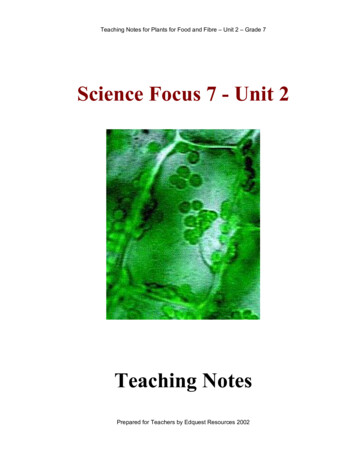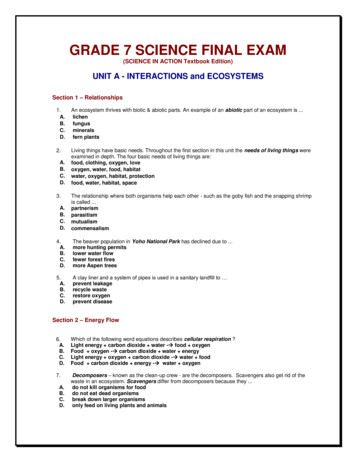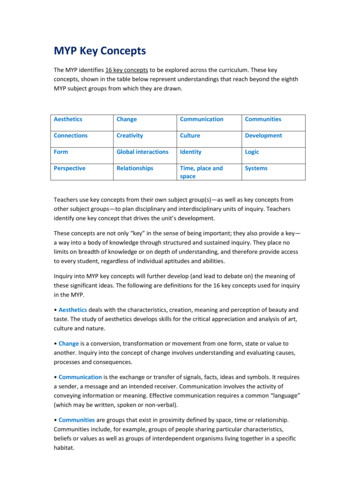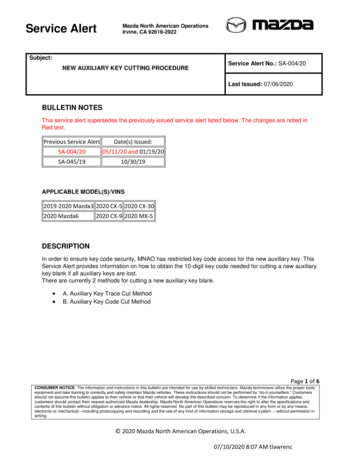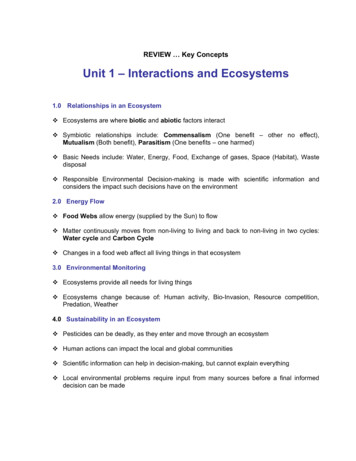
Transcription
REVIEW Key ConceptsUnit 1 – Interactions and Ecosystems1.0 Relationships in an EcosystemEcosystems are where biotic and abiotic factors interactSymbiotic relationships include: Commensalism (One benefit – other no effect),Mutualism (Both benefit), Parasitism (One benefits – one harmed)Basic Needs include: Water, Energy, Food, Exchange of gases, Space (Habitat), WastedisposalResponsible Environmental Decision-making is made with scientific information andconsiders the impact such decisions have on the environment2.0 Energy FlowFood Webs allow energy (supplied by the Sun) to flowMatter continuously moves from non-living to living and back to non-living in two cycles:Water cycle and Carbon CycleChanges in a food web affect all living things in that ecosystem3.0 Environmental MonitoringEcosystems provide all needs for living thingsEcosystems change because of: Human activity, Bio-Invasion, Resource competition,Predation, Weather4.0 Sustainability in an EcosystemPesticides can be deadly, as they enter and move through an ecosystemHuman actions can impact the local and global communitiesScientific information can help in decision-making, but cannot explain everythingLocal environmental problems require input from many sources before a final informeddecision can be made
1.0 Relationships in an EcosystemEcosystems are where biotic and abiotic factors interactDescribe the difference between biotic and abiotic parts of an ecosystemIllustrate your schoolyard and identify biotic and abiotic parts of that ecosystem. Indicate the variousrelationships between the biotic and abiotic parts in your schoolyard (with different colored lines) and abrief description of the relationship.Explain what each of the following is and give three examples to show you understand the unityExamples:
Basic Needs:What are the basic needs of living organisms in order for survival?What are some things that you could do without and still have all of your basic needs met?Symbiotic relationshipsWhat is symbiosis?Commensalism (One benefit – other no effect),Describe two examples of commensalismMutualism (Both benefit),Describe two examples of mutualismParasitism (One benefits – one harmed)Describe two examples of parasitism
There are two different types of adaptations: behavioral and structural.Describe each with examples and explain how each type of adaptation enables an organism to survive.Behavioral Adaptations1.2.Structural Adaptations1.2.Responsible Environmental Decision-making is made with scientific information and considers theimpact such decisions have on the environmentExplain why the beaver population in Yoho National Park was declining.What is the difference between a ‘dump’ or landfill – and a sanitary landfill?
List the 5 basic garbage ‘solutions’ we have been involved in to clean up our act.Describe some unintended consequences for discarding the plastic 6-pack pop/beer can holders inyour household garbage.2.0 Energy FlowEcosystem InteractionsDescribe each of the following consumers compared to each other.CarnivoresHerbivoresOmnivoresProducers can make their own food and supply the matter and energy they need for survival. Illustratethe food-making process of photosynthesis carried out by producers.
Illustrate a word equation for the process of photosynthesis.What are the two reasons that photosynthesis is important?Illustrate a word equation for the process of cellular respiration.What are the two reasons that photosynthesis is important?Describe the interaction/relationship between photosynthesis and cellular respiration.Describe the difference between scavengers and decomposers.
Complete the chart below identifying whether the organism is helpful or harmful and armfulWhyHarmfulHelpfulEcoli0157:H7HarmfulWhyFood Chains allow energy (supplied by the Sun) to flowIllustrate an example of a food chain (include arrows showing the flow of energy). Identify the type oforganism you are illustrating (eg. producer, primary consumer, secondary consumer, decomposer, etc.)
Illustrate the flow of energy from producer to primary consumer, to secondary consumer, to tertiaryconsumer, to scavenger, to decomposer.Food Webs allow energy (supplied by the Sun) to flowIllustrate a Meadow Food WebChanges in a food web affect all living things in that ecosystemWhat would happen if the meadow mice were poisoned and became extirpated?
Matter continuously moves from non-living to living and back to non-living in two cycles:Water cycle and Carbon CycleWhat are the three main processesresponsible for the Water Cycle?What activities or organisms addcarbon to the Atmosphere?What activities or organisms takecarbon out of the atmosphere?What other substance are cycled in the environment?
3.0 Environmental MonitoringEcosystems provide all needs for living thingsHow do scientists determine the distribution of organisms in an environment?Ecosystems change because of: human activity, Bio-Invasion, Resource competition,Predation, WeatherExplain the ecosystem changes identified and give an example of organisms that this affects.BioinvasionResource CompetitionPredationWeather
Describe the difference between Primary Succession and Secondary SuccessionWhat is a pioneer species and describe the role they play in an environment (their niche)?What is a climax community?4.0 Sustainability in an EcosystemPesticides can be deadly, as they enter and move through an ecosystemExplain the ‘unintended consequences’ of the use of the pesticide DDT, in Borneo.Human actions can impact the local and global communitiesWhy is DDT a banned chemical in North America?
What are the differences between threatened, endangered, extirpated, and extinct?Why are Pemberton potatoes special?Scientific information can help in decision-making, but cannot explain everythingWhat does COSEWIC stand for and what does it do?Describe one of the successes of COSEWICLocal environmental problems require input from many sources before a final informeddecision can be madeWhy are there ‘wildlife overpasses and underpasses’ in Banff national Park?
How effective are these wildlife structures (overpasses and underpasses)?How do you determine your ecological footprint?What are some ways you can reduce your ecological footprint?What is meant by sustainable lifestyle?
There are two different types of adaptations: behavioral and structural. Describe each with examples and explain how each type of adaptation enables an organism to survive. Behavioral Adaptations
